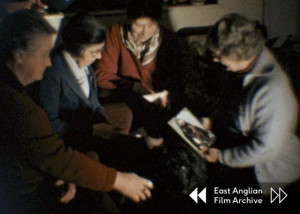
'Silent film shot by Miss Philippa Miller recording scenes of people and activities around the 1930s-style bay-fronted terraced houses and gardens in a small residential close at different seasons of the year. Miss Miller lived in Norwich so the film has provisionally been linked to Norwich, but identification of the location would be welcome. The film captures the relaxed and friendly relationship between the women, men and children filmed and Miss Miller behind the camera. From the film stock marks it appears that the film was shot between 1965 and 1967.
All but two of the scenes are filmed outdoors. Indoors we see four women sitting together looking at two boxed costume dolls and stroking a black poodle, and a brief scene of an elderly lady. The exterior scenes were filmed during winter, spring and summer and capture people's activities and domestic chores around their homes and gardens, their comings and goings, and various pet dogs. Scenes include: women clearing a path through snow; a row of ten sparrows on a ledge above a snowy roof; a man washing a car with cloth and bucket of water as laundry billows on a washing line; a woman dressed to go out in hat and coat carrying bags; children playing with a dog, a football, a toy pram and a toy tractor; a bride in white outfit with bouquet standing with a man, perhaps her father, and a woman chauffeur in peaked cap helping people into a car as they leave for a wedding; crocuses; another man washing a car; a boy on a tricycle; a knife grinder at work, operating his machine by treadle within a handcart with large wheels; a man mowing the lawn a man painting the front gate of a spring garden; a young man and woman; a man up a ladder cleaning windows; women with two children in matching coats; a house under construction with the timber frame of the upper storey and roof open; a woman hanging out sheets on a washing line; a woman shaded beneath a floral parasol standing in front of flowering rose bushes; a woman setting off on a bicycle; a woman holding a baby; children sitting on a lawn and playing with modelling clay; a young man; a woman at a window; a chaffinch; rose bushes; another lady dressed in hat and coat with bag going out; a woman playing ball with the black poodle; a man using an axe to chop at the roots in a hole around a tree stump' (EAFA).
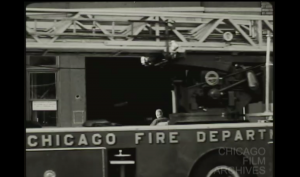
"University of Illinois Chicago (UICC) student film that documents the Chicago Fire Department house and fire officers of 158 West Erie Street. Images of the officers at work and play are interspersed with portraits of the firehouse, which is located in Chicago's River North neighborhood." Chicago Film Archives
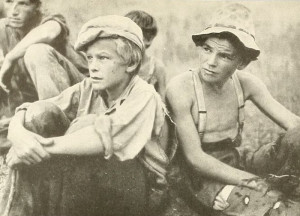
"The present fate and possible future of the southern share-cropping farmer have been pictured in dramatic and authentic detail by Alan S. Hacker, ACL, in a five reel, 16mm. film recently completed under the sponsorship of the Sharecropper Film Committee, New York City. Made to aid the Southern Tenant Farmers' Union, the production illustrates the agricultural despotism and destitution which have resulted in the formation of that group bargaining organization. Farms and families of Arkansas, Tennessee and Mississippi appear in this documentary record, which kept Mr. Hacker three months in the field. Lee R. Hays. an Arkansan, served him as liaison officer with the union and its supporters, while Gardner Jackson, of the film committee, contributed to the production's planning. Narrative comment and a musical background are scheduled additions to the pictured story, in preparation for screenings before school and civic groups interested in the success of the Southern Tenant Farmers' Union." - "Practical Films," Movie Makers, March 1937, 128.
"This humorous-sounding title suggests nothing of this film's content which has to do with a vacuum cleaner salesman and his tribulations when he is forced to pose as a woman, when a girl friend's husband arrives home unexpectedly. Both the exterior and interior shots are carefully exposed and a moderatly good editing job combines to make this a better than average effort." American Cinematographer, May 1951, 192.
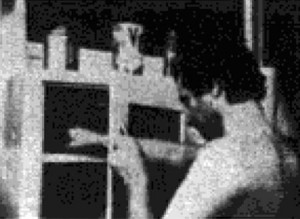
"The Applicant is a straightforward bit of cinema fare written and filmed by students at the New York University. The film deals with a sort of down-and-outer who appears to need a job in the worst way. So he looks in the want ads and finds a few businesses seeking applicants. He applies. Is he successful? Well, let's just say he gets something, but not exactly what you expect. The film relies to a great extent upon the acting of the central characters, and is not exactly a situation story, a genre often the easiest for amateurs to do. The lead character is well established, and the prospective employer does his job to perfection. The development of the plot, and the pacing are surely the outstanding aspects of this film which won for it not only the Gold Medal for the most outstanding film in the Festival, but also an automatic Ten Best rating, the MPD Scenario Award for the best Story film and a tie for the MPD Humorous film Award" PSA Journal, Aug. 1967, 35-36.
"Un-staged documentary footage shot and edited by Sallie Wagner. Sallie's description of the film: 'Shorty Boys, Little Shorty building a hogan, Crip Chee and his hogan, grandson in doorway. Blackrock in front of hogan, Tchindi, Rose Martin doing laundry, cooking shelter at squaw dance, Hosteen Glish getting water, Bent Knee getting wood, Hosteen Glish making a canoe out of a log, Hosteen Glish's granddaughter weaving, digging yucca root for soap, Navajo washing her hair, Hosteen Glish making a cradle board'." New Mexico State Archives.
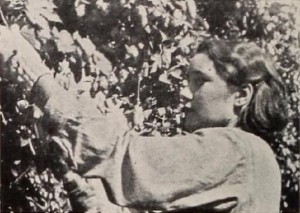
"Paul Thompson's Behind the Bale would be an amazing performance for a large studio, equipped with many facilities and numerous staff members, and this is true by reason of the exceedingly careful collaboration between the film editor and the comment writer. For a small producer of industrial pictures, Behind the Bale is a triumph in the technique of post recording, as well as a beautifully made picture that would stand on its own feet without narration and with relatively few titles. A Northwest brewer wishes to make it clear that the quality of hops has much to do with the quality of beer. Therefore, Mr. Thompson shows us the Yakima (Wash.) Valley briefly and then gets down to the special crop which the film pictures. We follow hops through planting, growing, picking and baling, in a Kodachromatic exposition that has rare beauty, and we end with four men enjoying the beer of Mr. Thompson's client. In the entire course of this fine piece of cinematography, there is a wizardry of cutting the film to fit the narration — and the reverse — that produces exposition timed with scene in a fashion that would do credit to the best industrial filmers anywhere." Movie Makers, Dec. 1941, 564.
"Like the title, it is really 'Beyond Manila.' It takes the follower into a country that has been little photographed, one part of that territory being the land of the Igorrote, in Northern Luzon. There is much to be seen of the people, the way they dress and live and work. There's abundant scenic beauty in the Philippines. We see many evidences of it in the pictures here shown of mountain and plain—of stream and waterfall. The natives, too, are real workers, women as well as men." American Cinematographer, Jan. 1939, 16.
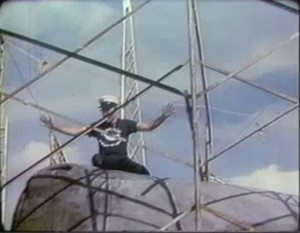
"In 1975, Connecticut made the sperm whale its official state animal, as a symbol of conservation. The following year, a group of volunteers from the Connecticut Cetacean Society spent over 5,000 hours building a life-size, 60-foot, ferro-cement model of a male sperm whale, on the grounds of the Children's Museum in West Hartford, Connecticut, USA. Director of the project was Robbins Barstow, who filmed this dramatic, home-made documentary." Archive.org
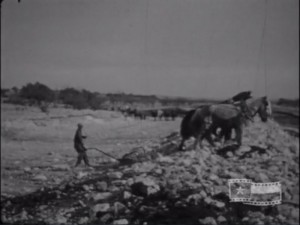
"Produced in the late 1920s, this amateur film documents the construction of the Santa Fe Railway extension connecting San Angelo and Sonora. In 1928, the Atchison, Topeka and Santa Fe Railway Company (Santa Fe) purchased the Kansas City, Mexico and Orient Railway Company of Texas (Orient of Texas). In so doing, they also acquired the company’s system of track lines, 465 miles of which were in Texas. As a subsidiary of Santa Fe, Orient of Texas then began construction on a pair of extension lines: one spanning the 72 miles from Paisano to Presidio and another the 65 miles from San Angelo to Sonora. This amateur film captures early construction on the second, with a small crew using work horses to clear the route and build bridges. The San Angelo-Sonora line was completed on July 1, 1930. Santa Fe abandoned the line in 1976" Texas Archive of the Moving Image.
Total Pages: 8